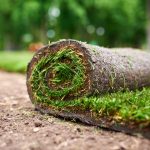Prepping Your Lawn for Winter
With fall just around the corner, we say goodbye to the hot, dry days of summer. But just because summer is coming to an end, doesn’t mean it’s time to let your yard go. What many homeowners don’t realize is that fall’s cool, wet weather provides the perfect condition to get your lawn ready for winter.
Mow
When prepping your lawn for winter, raise the blade length an inch to help increase the leaf area of your lawn. The larger the leaf area, the better it can store nutrients to survive and ward off weeds during the winter. After mowing the lawn, we suggest giving it a good rake to shake up the organic matter that accumulates on the surface.
Aerate
Once you’ve mowed and raked your lawn, the next step is to aerate. The small holes that are created by aeration actually increase the amount of air, water, and nutrients the grass roots receive, promoting growth. We suggest aerating your lawn at least 4 weeks before the first expected frost, giving it ample time to breathe and recover before the real cool weather arrives.
Overseed
Overseeding is the process of planting grass seed to help fill bald spots and increase the density of your lawn. The best time to overseed is the early fall, as it gives your lawn plenty of time to grow and strengthen its roots before winter. When choosing a grass seed, make sure that it is suited to fall overseeding and always follow the directions on the package. Immediately after overseeding you will need to water your lawn heavily, but once seeds have germinated you can reduce to a light watering once a day.
Fertilize
Fertilizing your lawn will help promote healthy growth and reduce the appearance of weeds, and is best done in the late fall. Using a high-phosphorus fertilizer is great if you’re looking to promote root growth, but is not necessary if your have an established lawn as it can pull enough phosphorous directly from the earth without the need of supplements. We suggest fertilizing your lawn while it’s still green, not when you start to notice yellow or dying blades, to helping to maximize the amount of food it is able to store for the winter.
Rake
Throughout the fall, it’s also important to keep up with raking fallen leaves. If left to accumulate, the weight of these leaves can damage the grass you’ve worked so hard to grow, reducing its chances of surviving the winter
To learn more about prepping your lawn for winter or for answers to any of your other lawn questions, give us a call. Our dedicated team of experts are here to answer any of your questions.







